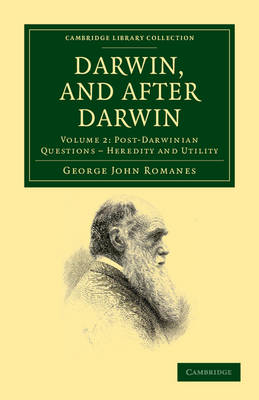
Darwin, and after Darwin
An Exposition of the Darwinian Theory and Discussion of Post-Darwinian Questions
Seiten
2011
Cambridge University Press (Verlag)
978-1-108-03810-2 (ISBN)
Cambridge University Press (Verlag)
978-1-108-03810-2 (ISBN)
Written by evolutionary biologist and Royal Society Fellow George John Romanes (1848–94), this three-volume study of Darwin's work considers the many implications of evolution by natural selection. Published posthumously in 1895, Volume 2 focuses on the 'post-Darwinian questions' of heredity and utility in organisms.
George John Romanes (1848–94), evolutionary biologist, was one of the most zealous supporters of Darwin's theory of evolution by natural selection in the nineteenth century. He met Darwin in 1874 and became a firm friend and follower, applying Darwinian theory to his work on animal intelligence and mental evolution. Romanes was elected to the Royal Society in 1879 at the age of 31, having produced his own influential research on the evolution of the nervous system. This three-volume study of Darwin's work and its implications was first developed as a series of lectures given in Edinburgh and London between 1886 and 1890. Controversially, Romanes deviates from Darwin's assertion of the significance of geographical isolation, contending that physiological differences among the same species were central to evolutionary change. Published posthumously in 1895, Volume 2 focuses on the 'post-Darwinian questions' of heredity and utility in organisms.
George John Romanes (1848–94), evolutionary biologist, was one of the most zealous supporters of Darwin's theory of evolution by natural selection in the nineteenth century. He met Darwin in 1874 and became a firm friend and follower, applying Darwinian theory to his work on animal intelligence and mental evolution. Romanes was elected to the Royal Society in 1879 at the age of 31, having produced his own influential research on the evolution of the nervous system. This three-volume study of Darwin's work and its implications was first developed as a series of lectures given in Edinburgh and London between 1886 and 1890. Controversially, Romanes deviates from Darwin's assertion of the significance of geographical isolation, contending that physiological differences among the same species were central to evolutionary change. Published posthumously in 1895, Volume 2 focuses on the 'post-Darwinian questions' of heredity and utility in organisms.
Preface; Note; 1. Introductory: the Darwinism of Darwin and of the post-Darwinian schools; 2. Characters as hereditary and acquired (preliminary); 3. Characters as hereditary and acquired (continued); 4. Characters as hereditary and acquired (continued); 5. Characters as hereditary and acquired (continued); 6. Characters as hereditary and acquired (concluded); 7. Characters as adaptive and specific; 8. Characters as adaptive and specific (continued); 9. Characters as adaptive and specific (continued); 10. Characters as adaptive and specific (concluded); Summary; Appendix; Notes; Index.
| Erscheint lt. Verlag | 3.11.2011 |
|---|---|
| Reihe/Serie | Cambridge Library Collection - Darwin, Evolution and Genetics ; Volume 2 |
| Zusatzinfo | 1 Plates, black and white; 5 Halftones, unspecified |
| Verlagsort | Cambridge |
| Sprache | englisch |
| Maße | 140 x 216 mm |
| Gewicht | 460 g |
| Themenwelt | Naturwissenschaften ► Biologie ► Evolution |
| ISBN-10 | 1-108-03810-7 / 1108038107 |
| ISBN-13 | 978-1-108-03810-2 / 9781108038102 |
| Zustand | Neuware |
| Haben Sie eine Frage zum Produkt? |
Mehr entdecken
aus dem Bereich
aus dem Bereich
Komplette Neuübersetzung. Mit einem Nachwort von Josef H. Reichholf.
Buch | Hardcover (2018)
Klett-Cotta (Verlag)
CHF 67,20
Wie die Vernichtung der Arten unser Überleben bedroht - Der …
Buch | Softcover (2023)
Penguin (Verlag)
CHF 20,95


